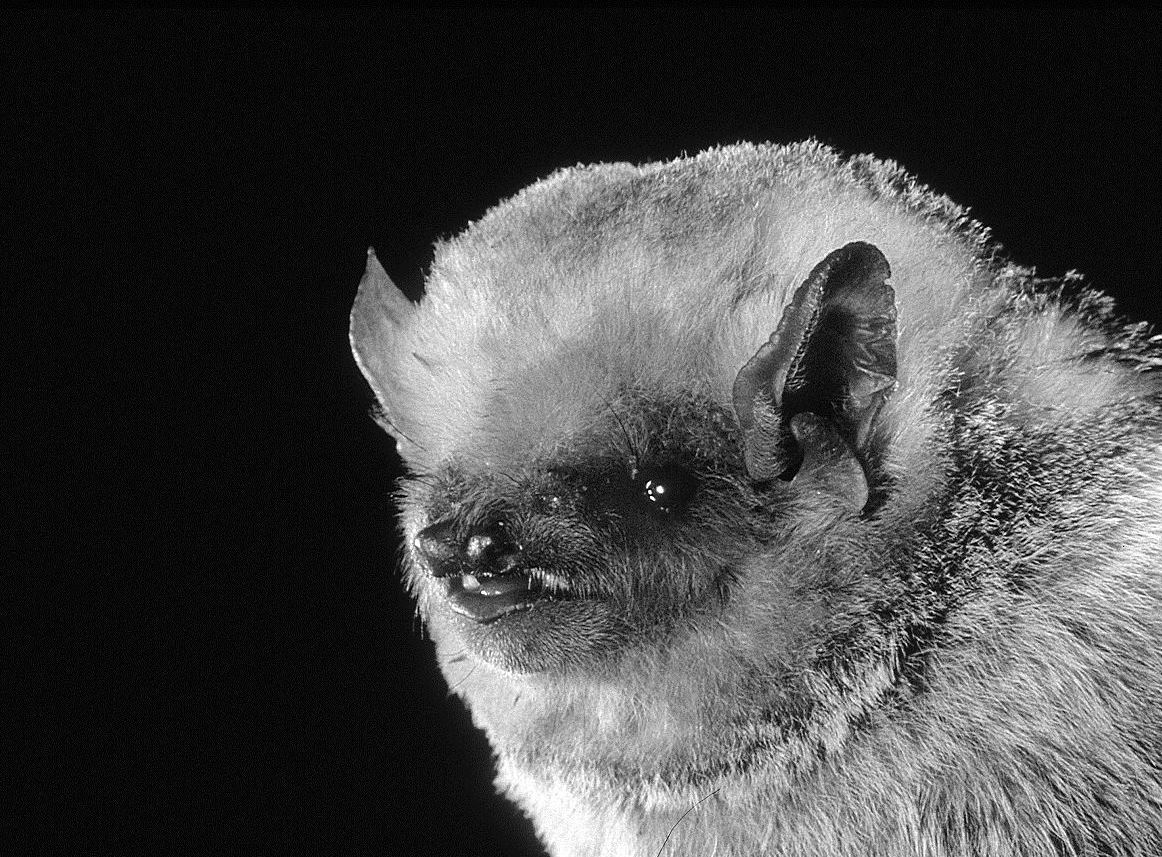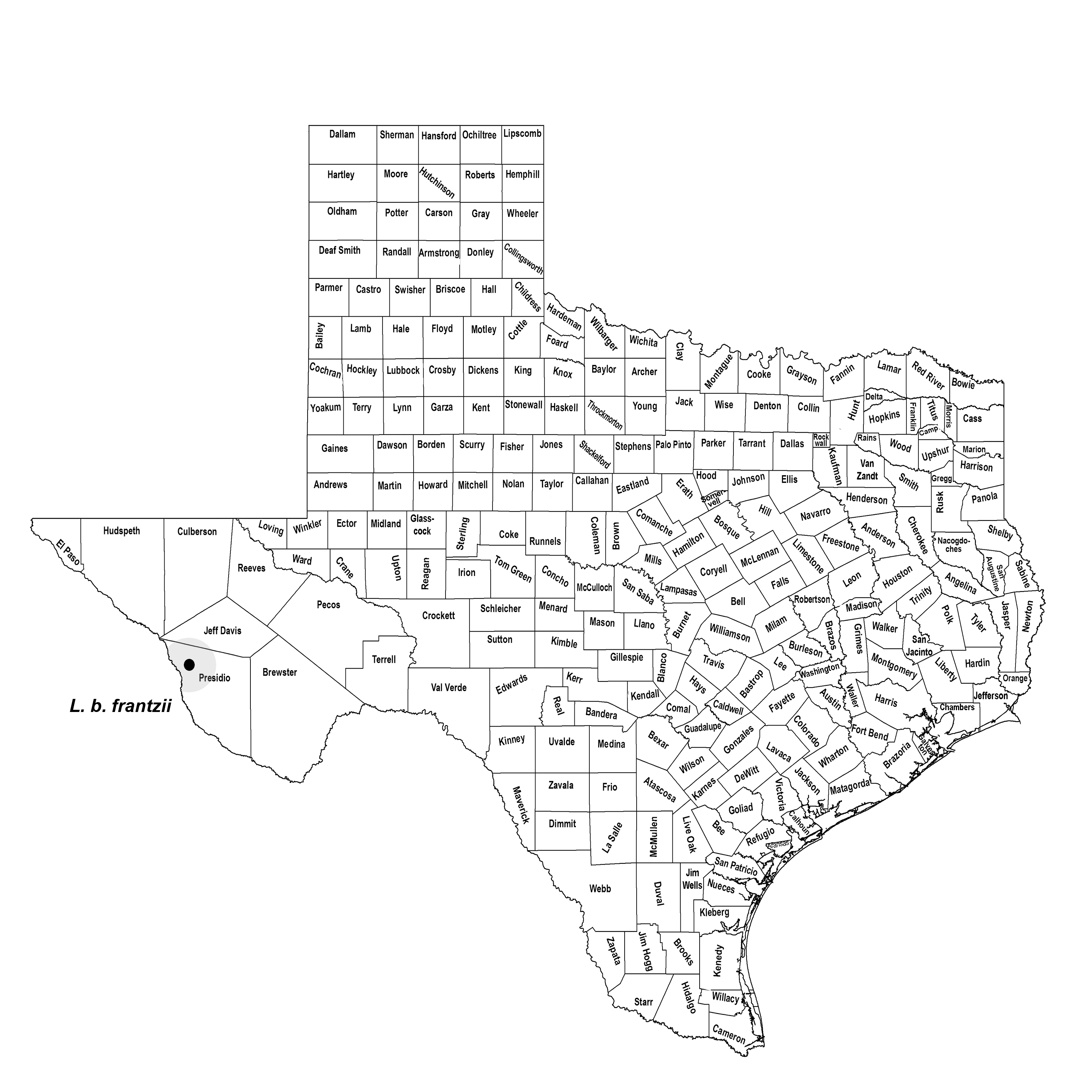WESTERN RED BAT
Lasiurus blossevillii (Lesson 1826)
Order Chiroptera : Family Vespertilionidae
DESCRIPTION. A medium-sized bat similar in appearance to the eastern red bat (L. borealis). Pelage coloration is rusty red to brownish and lacks the white-tipped hairs that give the frosted appearance so characteristic of L. borealis. The posterior one-third of the interfemoral membrane is bare or only sparsely haired. Lasiurus blossevillii is slightly smaller than L. borealis, and most cranial measurements (greatest length of skull, zygomatic breadth, mastoid breadth, and length of maxillary tooth row) are significantly smaller. Dental formula: I 1/3, C 1/1, Pm 2/2, M 3/3 × 2 = 32. Averages for external measurements: total length, 103 mm; tail, 49 mm; foot, 10 mm; ear from notch, 13 mm; forearm, 40 mm. Weight, 7–15 g.

DISTRIBUTION. This bat ranges across the southwestern and far western areas of the United States south into Mexico and Central America. It is known in Texas from only one specimen, collected on 15 July 1988, from the Sierra Vieja Mountains of Presidio County in the Trans-Pecos vegetative area.

SUBSPECIES. Two subspecies of L. blossevillii are recognized. The first, L. b. blossevillii, is found only in South America. The second, L. b. frantzii, occurs in Central and North America and has been documented in Texas.
HABITS. Western red bats appear to prefer riparian areas, where they roost in tree foliage. In New Mexico and Arizona this bat is occasionally captured in riparian habitats dominated by cottonwoods, oaks, sycamores, and walnuts and is rarely found in desert habitats. In Mexico, this bat has been captured in riparian, xeric thorn scrub and pine–oak forests of the San Carlos Mountains, only 160 km (99 mi.) south of the Texas border. The Texas specimen was captured over permanent water in desert scrub habitat.
This bat appears to be migratory in the southwestern United States. Specimens from Arizona, New Mexico, and Texas are all from summer. A winter withdrawal from this region to Mexico is likely.
The food habits and reproductive biology of this bat are poorly known. Females pregnant with three fetuses have been captured, and pregnant bats from New Mexico have been caught from mid-May to late June. Lasiurus blossevillii may raise as many as three young annually, with parturition occurring in mid-May through late June.
POPULATION STATUS. Rare, summer resident. There is but one record of the western red bat in western Texas, and there is a real need to look for it in other areas of the Trans-Pecos. In Arizona and New Mexico it is relatively common in riparian forest canopies associated with streams in desert mountain ranges.
CONSERVATION STATUS. The IUCN status of the western red bat is least concern, and it is not included on the federal or state government lists of concerned species. Because it is rare and has such a patchy distribution, more work is needed to determine its status and whether a resident population occurs in the Trans-Pecos.
Remarks. A major taxonomic rearrangement of the genera and species of tree bats has recently been adopted based on the work of Amy Bickham Baird and her father, John Bickham, both well-known molecular systematists who work in Texas. In 2015, these authors published a paper in the Journal of Mammalogy (volume 96) in which they used mitochondrial and Y-chromosomal DNA to reassess the evolutionary relationships of tree bats of the genus Lasiurus. Under their new proposed taxonomic arrangement, which we have followed in this volume, tree bats in Texas, which heretofore were all included in the single genus Lasiurus, now are placed into three different genera: hoary bats (Aeorestes), red bats (Lasiurus), and yellow bats (Dasypterus).
From The Mammals of Texas, Seventh Edition by David J. Schmidly and Robert D. Bradley, copyright © 1994, 2004, 2016. Courtesy of the University of Texas Press.
Natural Science Research Laboratory
-
Address
Museum of Texas Tech University, 3301 4th street, Lubbock, TX 79409 -
Phone
806.742.2486 -
Email
nsrl.museum@ttu.edu

